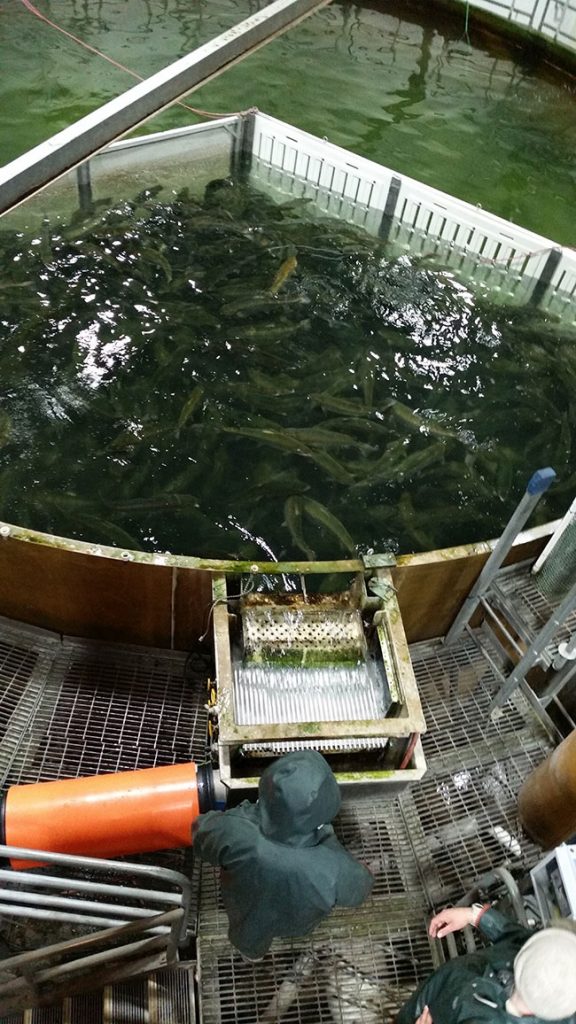
Industry update
News
How-to
How solid waste put aquaculture systems at risk
March 3, 2020 By Nestor Arellano
 Recirculating aquaculture systems (RAS) technology development has been and continues to be a melding of borrowed engineering.
Recirculating aquaculture systems (RAS) technology development has been and continues to be a melding of borrowed engineering.Solid waste is the most harmful type of waste in fish culture systems, according to a recent report.
The two major sources of solid wastes in aquaculture are uneaten feed and various undigested substances, which are passed through as fecal waste, a study conducted by
The researchers recommended that operators of recirculating aquaculture systems (RAS), flow-through aquaculture systems, and pond-based fish culture systems need to employ biofloc technology (BFT) to ensure the maintenance of adequate water quality through the uptake of ammonia to produce microbial proteins.
Dissolved waste
Dissolved organic wastes in fish culture systems are primarily nitrogen and phosphorus. There are different techniques for nitrogen removal in fish culture systems but not for readily removing phosphorus. Phosphorus is not toxic to cultured fish, unlike nitrogen, which has toxic forms like ammonia and nitrite.
Nitrogen removal
The pond systems rely on natural processes – mostly their microbial communities working on oxidizing organic matter and converting ammonia to other forms – to maintain water quality.
The ammonia is converted to the less toxic nitrate, and together with phosphate are nutrients for the phytoplankton and macroalgae in the pond ecosystem. The phytoplankton is fed upon by the zooplankton and finally consumed by many fish species.
“However, the ability of the pond system to manage aquaculture waste is limited and depends directly upon the amount of waste that can be recycled by the pond daily,” the report said. “Any amounts beyond this limit may lead to excessive nutrient enrichment of the pond, eutrophication and the death of fish in the culture unit.”
Pond culture systems
Pond culture systems are static and usually have no water treatment. These systems rely on internal processes where solid wastes settle on the bottom of the pond and accumulate over time.
The microbes in the system act on the settled waste and convert it to less-toxic materials.
“However, if the settled waste has accumulated over time, any natural activities like bank erosion can cause the mixing of the highly nutritious pond bottom with the water column and may lead to algal blooms,” the report said.
Flow-through systems
Flow-through systems have high rates of water exchange and most of the wastes produced are discharged from the culture unit. If properly designed, flow-through systems collect and concentrate the solid wastes before they fragment.
However, the report said, the major problem of solid waste management in these systems is that the wastes are difficult and expensive to manage because of a high flow rate of weakly-concentrated effluents.
RAS systems
RAS remove solid wastes through sedimentation and screen filters. These systems take away a large portion of solid wastes through sedimentation, they are not effective in removing fine solids, so supplementary screening is needed. RAS systems reportedly can remove 85 to 98 per cent of organic matter and suspended solids, and 65 to 96 per cent of phosphorus through the effective removal of solid wastes, the report said.
BFT
Biofloc technology is a water quality management technique that is based on the development and control of heterotrophic bacteria within the culture system with minimal or zero water exchange.
“The microbial community (cellular protein) contains a heterogeneous mixture of microorganisms (floc formers and filamentous bacteria), particles, colloids, organic polymers, cations, and dead cells,” the report said. “BFT helps ensure the maintenance of adequate water quality through the uptake of ammonia to produce microbial proteins, and it also makes available food for the cultured fish through the utilization of the microbial protein produced, thus increasing the efficient utilization of the aquafeed applied, improving food conversion ratios and decreasing the cost of feeding in aquaculture.”
Print this page